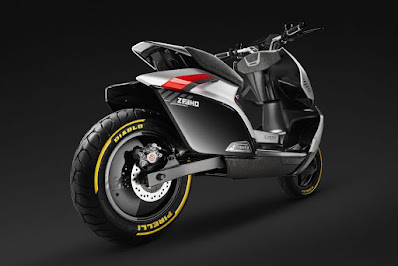Rare ONES Wow, what brand of scooter is this? Where does it come from? These questions were raised when we first saw it on the internet. At first glance, the shape looks like a British-made scooter with the characteristics of a large front fender. But after we dig deeper and found that the scooter is one of the scooters made by Austrian manufacturer. This is shown an indication that the world's scooter trend of 1950s that occurred in Austria was quite booming, this can be seen by the presence of so many scooter brands that have been born from the country.
 |
| 1955 HMW 75 RG Bambi scooter. (Picture from: http://bit.ly/3ryb8FD) |
You will remember, some time ago, we submitted several articles discussing the 1950s scooters made by Austrian manufacturers, such as the Colibri from Josef Walter & Co or several scooter models made by KTM ranging from Mirabel, Mecky to Pony. Then there are several scooter models produced by Puch, then there are scooters designed by Otto Kauba that are made and also marketed into several other brands.
 |
| 1954 HMW 75 RG Prototype. (Picture from: http://bit.ly/2MxvrEp) |
The scooters that will be discussed this time are less well known, and rarely known to scooter enthusiasts outside Austria. The Austrian manufacturer, Halleiner Motoren Werke A.G. (HMW) was founded by Ing. Anton Fuchs and Franz Hinterberger in 1946 and operated to 1962 had produce several products including the Fuchs 49cc bicycle engine, several mopeds and other light-class two-wheeled vehicles as well as several scooter models.
 |
| 1955 HMW 75 RG Bambi scooter. (Picture from: http://bit.ly/2MxvrEp) |
At the time the Hallein-based manufacturer was succes becoming the king in the moped market, with the HMW Fuchs built-in motor. But when the scooter fever hit the world, made the Austrian manufacturer was also interested in making it. And in the 1954 Vienna-held spring trade fair, surprisingly the company launched a prototype scooter called the HMW 75RG. The prototype scooter form is similar in simplicity to the early Kauba and Lambretta, but much prettier.
 |
| 1958 Cosmo HMW Bambi scooter vintage print flyer. (Picture from: http://ebay.to/3jo73kp) |
It is not known why the scooter name is the same as a Walt Disney's cartoon series entitled Bambi produced by MGM Film. It is thought that the name was considered a form of appealing to consumers only. Finally, the name using was stopped altogether, after receiving objections from the company that produced the cartoon.
 |
| 1958 HMW Super Luxus moped. (Picture from: http://bit.ly/36OgC78) |
Unfortunately, the scooters sales figures in the market did not go according to plan, and the use of a 75cc engine was said to be the reason. As qouted of fahrzeuge.dorotheum.com, the engine was considered lousy to carry the 100 kg-weighted scooter for agile running on the streets, and even not to be better by the use of a two-speed manual gearbox.😏
In the first year (1955) it turned out that the Bambi model sold only 314 units and in the following year only 95 units. The often rumored 1,200 units sold numbers might fall into the fairytale category, even as some rebadged as the Cosmo 80 models exported to America ended up with the losing money.😒 It seems that the company has not given up yet on the loss in the scooter sales, it's still pushing its luck by producing the moped-scooter mixed two-wheeled vehicle models.
 |
| 1957 HMW 50 Maya sat on display at the HMW Sonderausstellung Keltenmuseum, Hallein, Land Salzburg, Austria. (Picture from: http://bit.ly/3pX3x31) |
The company's next scooter product named the HMW 50 Maya of the 1957 and the next folowing year the company moved from Hallein to Kottingbrunn, and production of the Bambi scooter was stopped, thus Bambi as the name of the scooter model then disappeared. Shortly after in the 1959 that the Austrian manufacturer once again started production of another underpowered moped-scooter mixed two-wheeled vehicle named the HMW 50 Conny.
 |
| 1959 HMW 50 Conny sat on display at the HMW Sonderausstellung Keltenmuseum, Hallein, Land Salzburg, Austria. (Picture from: http://bit.ly/3pX3x31) |
The manufacturer continued to produce mopeds until the 1960s, before actually ceasing its operations in 1962. It seems that the company's products have difficulty competing in the market, which has an impact on the company's financial which has deteriorated. Finally on May 16, 1962, the Austrian manufacturer stopped all production after producing approximately 128,175 units of two-wheeled vehicles of various types including mopeds and scooters.😭
That's
it, and if the article above is still considered inadequate or
inaccurate, or if you have additional information related to these Austrian HMW's
unique-shaped scooters, please don't hesitate to let us
know via
the comments column below this article.
Kept spur your adrenaline on the power of the two-wheeled monster and stay alive with true safety riding. May God will forgive Your sins and so does the cops...... *** [EKA | FROM VARIOUS SOURCES | HMW-ZWEIRAD.AT | AUSTROCLASSIC.AT | WIKIPEDIA | CYBERMOTORCYCLE.COM | FAHRZEUGE.DOROTHEUM.COM | FLICKRIVER.COM ]
Note: This blog can be accessed via your smart phone.


































